
“Latin is a language
As dead as dead can be.
It killed the ancient Romans
And now it’s killing me.”
Students of Latin for any length of time (six years for us, thank you very much) knew this stanza. It first appeared in a Los Angeles newspaper back in 1909 and was quickly embraced by those who couldn’t see the point of learning a language that no living person spoke. That said, hundreds of generations believed that knowing Latin (and Greek) indicated that a person was well educated; former Latin students grudgingly admit that knowing Latin helped them learn other Romance languages or decipher the meaning of an unfamiliar word because they knew Latin suffixes and prefixes. In fact, we once read that knowing a single Latin root word can unlock the meaning of over 100 other words.
Most people believe that the Aztec language is also dead, having vanished with the last of the Aztecs in the 16th century. In fact, it is thriving. Some 1.7 million people speak a form of Náhuatl, the tongue spoken by Aztecs, and if you’ve ever said the words, “chocolate, “coyote,” “avocado,” “tomato,” “chili,” “ocelot,” or “chipotle,” you, too, have spoken words that are derivatives of Náhuatl because it worked its way into Spanish. Unlike Latin which is still offered in many schools, the University of Utah is the only U.S. academic institution that teaches Náhuatl on a regular basis.
If you are a dog person, you have also spoken Náhuatl every time you said “Chihuahua” or “Xoloitzcuintli.”
Initially, the modern-day Chihuahua was called the Arizona dog, Texas dog, and the Mexico dog, but eventually, the breed was named for the mountainous province located in the north of Mexico named Chihuahua. Many experts believe the breed’s ancestors originated from the region over 1,000 years ago, its ancestor the larger Techichi, preferred breed of the Toltecs who were conquered by the Aztecs in the 12th century. The Aztecs refined the Techichi into a smaller, lighter dog, but the name we know them by, “Chihuahua,” comes from a Náhuatl word meaning dry, sandy place.
Another Mexican breed, the Xoloitzcuintli, has been around for at least 3,000 years, archaeological evidence suggesting that the dogs accompanied the first humans across the Bering Strait. The dogs lived in the jungles of Mexico, but they didn’t go unnoticed. Along with turkeys, Xolos became one of the only domesticated animals eaten by ancient Mesoamericans, and when the conquistadors arrived, they developed such an appetite for the handy source of canine protein that they nearly ate the breed into oblivion, this according to director of the Tijeras Pueblo Museum, archaeologist Marc Thompson. The breed got its name from two Náhuatl words, “Xolotl,” the god of lightning and death, and “itzcuintli,” or dog. According to Aztec belief, the Dog of Xolotl was created by the god to guard the living and guide the souls of the dead through the dangers of Mictlán, the Underworld. It’s a marvel the breed survived at all, having been either eaten or dispatched to accompany the dead. Indeed, by the time the breed was officially recognized in Mexico in 1956, the breed actually was nearly extinct.
Interestingly, in 2020, the DNA sequencing of ancient dog genomes found that the Xoloitzcuintle retained 3% of its pre-colonial ancestry, and the Chihuahua retained 4%. Our breeds really are living museum pieces.
If you think you’d like to learn Náhuatl, we found a You Tube video that is a series of lessons. The first one is below:
Image: “Two Mexican Dogs Collection” is designed from a digital enhanced image published in 1919 by National Geographic Society in “The Book of Dogs – Our Common Dogs” by Louis Agassiz Fuertes and Ernest Harold Baynes with illustrations By Louis Agassiz Fuertes. It is offered in various forms at the Etsy shop of BelsLittleLiver
